Tax Compliance and Avoidance in Australia
VerifiedAdded on 2020/03/23
|10
|2794
|114
AI Summary
This assignment delves into the complexities of tax compliance and avoidance in Australia. It explores empirical evidence on income tax compliance costs for working individuals, the impact of managing tax risk on large Australian companies' behavior, and the effectiveness of personal and corporate income tax changes. The analysis also considers how financial distress influences corporate tax avoidance during economic crises, the role of incentives in corporate tax planning, and the determinants of tax haven utilization by Australian firms.
Contribute Materials
Your contribution can guide someone’s learning journey. Share your
documents today.

Running head: TAXATION
Taxation
Name of the Student
Name of the University
Authors Note
Course ID
Taxation
Name of the Student
Name of the University
Authors Note
Course ID
Secure Best Marks with AI Grader
Need help grading? Try our AI Grader for instant feedback on your assignments.
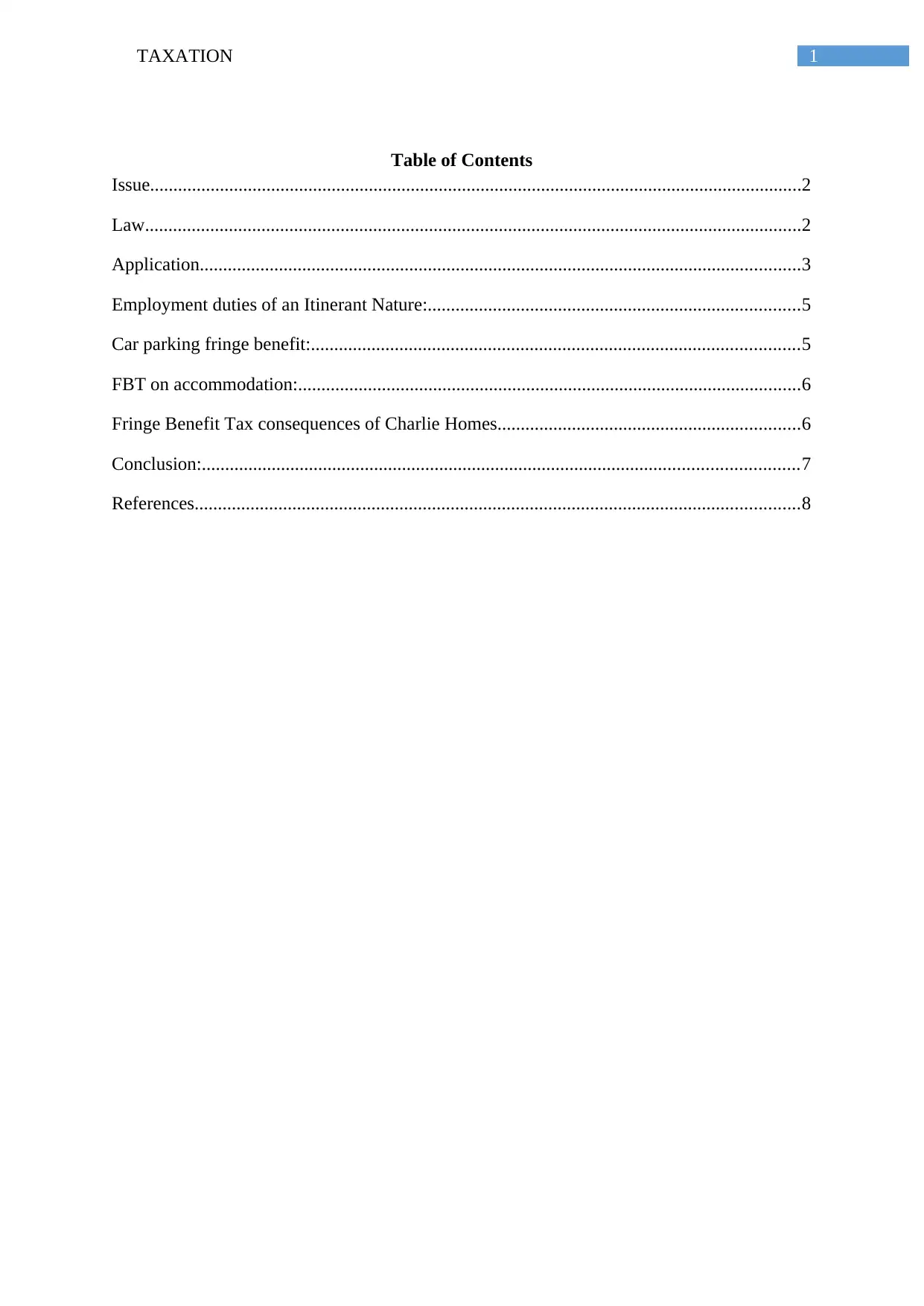
1TAXATION
Table of Contents
Issue............................................................................................................................................2
Law.............................................................................................................................................2
Application.................................................................................................................................3
Employment duties of an Itinerant Nature:................................................................................5
Car parking fringe benefit:.........................................................................................................5
FBT on accommodation:............................................................................................................6
Fringe Benefit Tax consequences of Charlie Homes.................................................................6
Conclusion:................................................................................................................................7
References..................................................................................................................................8
Table of Contents
Issue............................................................................................................................................2
Law.............................................................................................................................................2
Application.................................................................................................................................3
Employment duties of an Itinerant Nature:................................................................................5
Car parking fringe benefit:.........................................................................................................5
FBT on accommodation:............................................................................................................6
Fringe Benefit Tax consequences of Charlie Homes.................................................................6
Conclusion:................................................................................................................................7
References..................................................................................................................................8
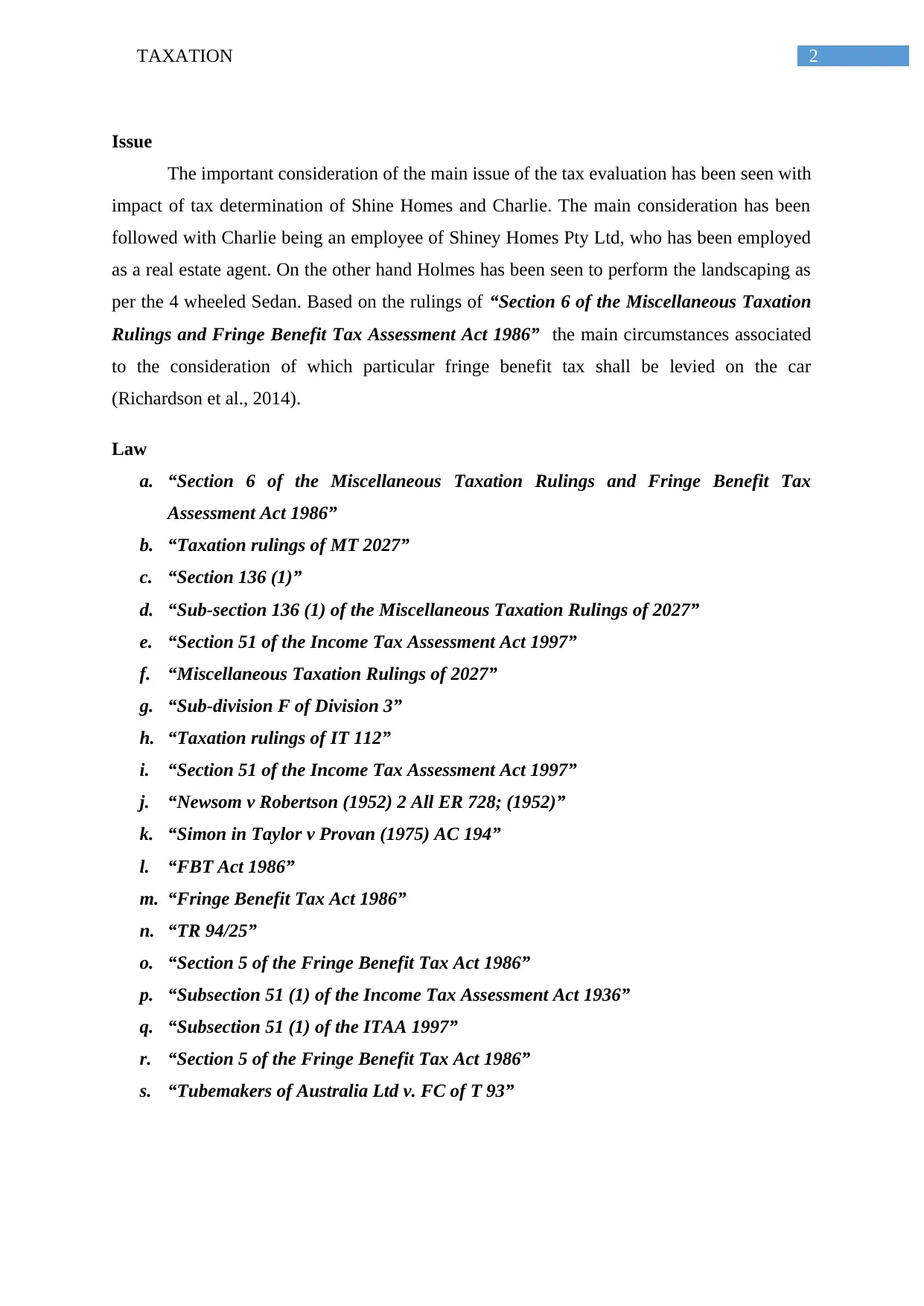
2TAXATION
Issue
The important consideration of the main issue of the tax evaluation has been seen with
impact of tax determination of Shine Homes and Charlie. The main consideration has been
followed with Charlie being an employee of Shiney Homes Pty Ltd, who has been employed
as a real estate agent. On the other hand Holmes has been seen to perform the landscaping as
per the 4 wheeled Sedan. Based on the rulings of “Section 6 of the Miscellaneous Taxation
Rulings and Fringe Benefit Tax Assessment Act 1986” the main circumstances associated
to the consideration of which particular fringe benefit tax shall be levied on the car
(Richardson et al., 2014).
Law
a. “Section 6 of the Miscellaneous Taxation Rulings and Fringe Benefit Tax
Assessment Act 1986”
b. “Taxation rulings of MT 2027”
c. “Section 136 (1)”
d. “Sub-section 136 (1) of the Miscellaneous Taxation Rulings of 2027”
e. “Section 51 of the Income Tax Assessment Act 1997”
f. “Miscellaneous Taxation Rulings of 2027”
g. “Sub-division F of Division 3”
h. “Taxation rulings of IT 112”
i. “Section 51 of the Income Tax Assessment Act 1997”
j. “Newsom v Robertson (1952) 2 All ER 728; (1952)”
k. “Simon in Taylor v Provan (1975) AC 194”
l. “FBT Act 1986”
m. “Fringe Benefit Tax Act 1986”
n. “TR 94/25”
o. “Section 5 of the Fringe Benefit Tax Act 1986”
p. “Subsection 51 (1) of the Income Tax Assessment Act 1936”
q. “Subsection 51 (1) of the ITAA 1997”
r. “Section 5 of the Fringe Benefit Tax Act 1986”
s. “Tubemakers of Australia Ltd v. FC of T 93”
Issue
The important consideration of the main issue of the tax evaluation has been seen with
impact of tax determination of Shine Homes and Charlie. The main consideration has been
followed with Charlie being an employee of Shiney Homes Pty Ltd, who has been employed
as a real estate agent. On the other hand Holmes has been seen to perform the landscaping as
per the 4 wheeled Sedan. Based on the rulings of “Section 6 of the Miscellaneous Taxation
Rulings and Fringe Benefit Tax Assessment Act 1986” the main circumstances associated
to the consideration of which particular fringe benefit tax shall be levied on the car
(Richardson et al., 2014).
Law
a. “Section 6 of the Miscellaneous Taxation Rulings and Fringe Benefit Tax
Assessment Act 1986”
b. “Taxation rulings of MT 2027”
c. “Section 136 (1)”
d. “Sub-section 136 (1) of the Miscellaneous Taxation Rulings of 2027”
e. “Section 51 of the Income Tax Assessment Act 1997”
f. “Miscellaneous Taxation Rulings of 2027”
g. “Sub-division F of Division 3”
h. “Taxation rulings of IT 112”
i. “Section 51 of the Income Tax Assessment Act 1997”
j. “Newsom v Robertson (1952) 2 All ER 728; (1952)”
k. “Simon in Taylor v Provan (1975) AC 194”
l. “FBT Act 1986”
m. “Fringe Benefit Tax Act 1986”
n. “TR 94/25”
o. “Section 5 of the Fringe Benefit Tax Act 1986”
p. “Subsection 51 (1) of the Income Tax Assessment Act 1936”
q. “Subsection 51 (1) of the ITAA 1997”
r. “Section 5 of the Fringe Benefit Tax Act 1986”
s. “Tubemakers of Australia Ltd v. FC of T 93”
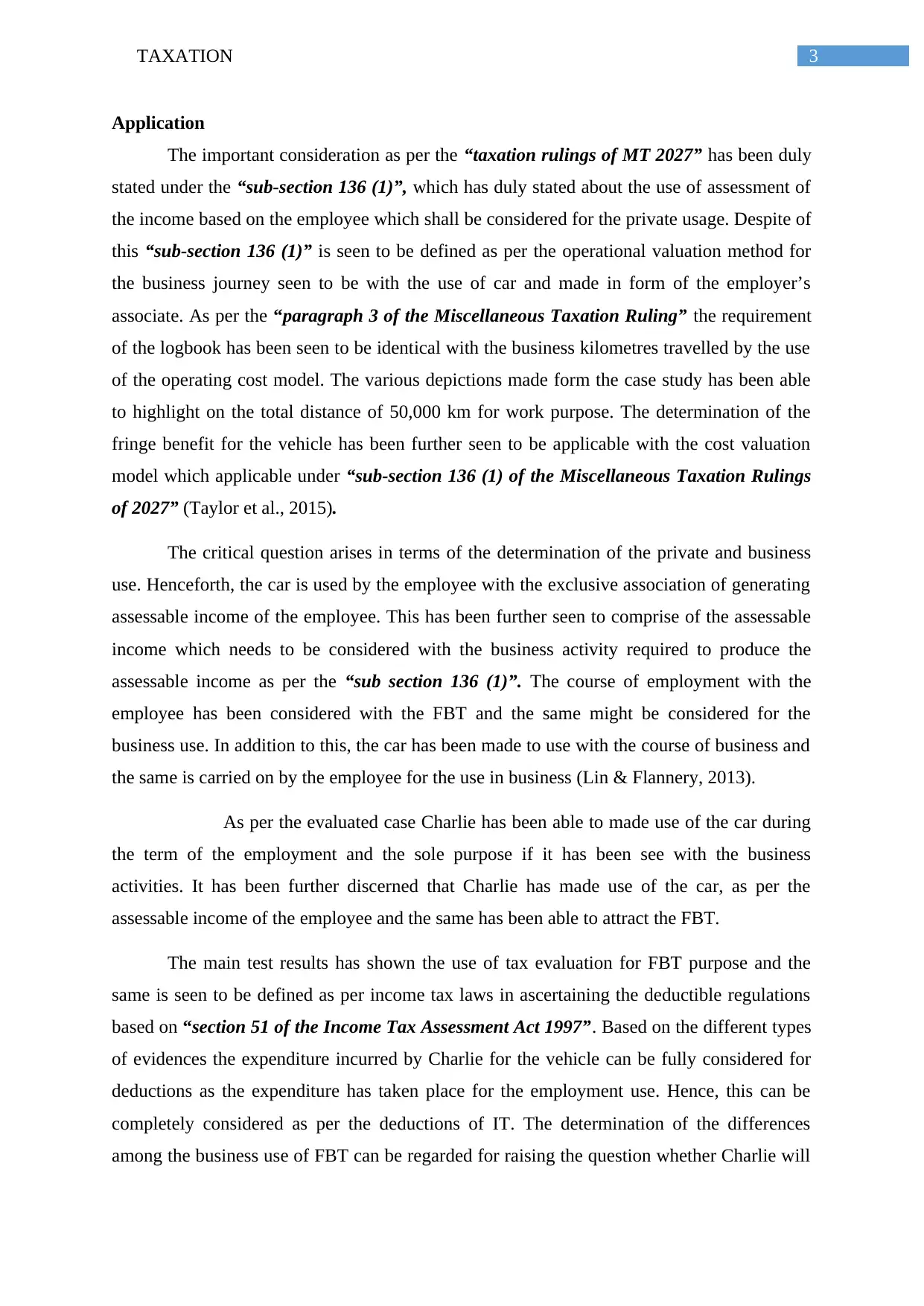
3TAXATION
Application
The important consideration as per the “taxation rulings of MT 2027” has been duly
stated under the “sub-section 136 (1)”, which has duly stated about the use of assessment of
the income based on the employee which shall be considered for the private usage. Despite of
this “sub-section 136 (1)” is seen to be defined as per the operational valuation method for
the business journey seen to be with the use of car and made in form of the employer’s
associate. As per the “paragraph 3 of the Miscellaneous Taxation Ruling” the requirement
of the logbook has been seen to be identical with the business kilometres travelled by the use
of the operating cost model. The various depictions made form the case study has been able
to highlight on the total distance of 50,000 km for work purpose. The determination of the
fringe benefit for the vehicle has been further seen to be applicable with the cost valuation
model which applicable under “sub-section 136 (1) of the Miscellaneous Taxation Rulings
of 2027” (Taylor et al., 2015).
The critical question arises in terms of the determination of the private and business
use. Henceforth, the car is used by the employee with the exclusive association of generating
assessable income of the employee. This has been further seen to comprise of the assessable
income which needs to be considered with the business activity required to produce the
assessable income as per the “sub section 136 (1)”. The course of employment with the
employee has been considered with the FBT and the same might be considered for the
business use. In addition to this, the car has been made to use with the course of business and
the same is carried on by the employee for the use in business (Lin & Flannery, 2013).
As per the evaluated case Charlie has been able to made use of the car during
the term of the employment and the sole purpose if it has been see with the business
activities. It has been further discerned that Charlie has made use of the car, as per the
assessable income of the employee and the same has been able to attract the FBT.
The main test results has shown the use of tax evaluation for FBT purpose and the
same is seen to be defined as per income tax laws in ascertaining the deductible regulations
based on “section 51 of the Income Tax Assessment Act 1997”. Based on the different types
of evidences the expenditure incurred by Charlie for the vehicle can be fully considered for
deductions as the expenditure has taken place for the employment use. Hence, this can be
completely considered as per the deductions of IT. The determination of the differences
among the business use of FBT can be regarded for raising the question whether Charlie will
Application
The important consideration as per the “taxation rulings of MT 2027” has been duly
stated under the “sub-section 136 (1)”, which has duly stated about the use of assessment of
the income based on the employee which shall be considered for the private usage. Despite of
this “sub-section 136 (1)” is seen to be defined as per the operational valuation method for
the business journey seen to be with the use of car and made in form of the employer’s
associate. As per the “paragraph 3 of the Miscellaneous Taxation Ruling” the requirement
of the logbook has been seen to be identical with the business kilometres travelled by the use
of the operating cost model. The various depictions made form the case study has been able
to highlight on the total distance of 50,000 km for work purpose. The determination of the
fringe benefit for the vehicle has been further seen to be applicable with the cost valuation
model which applicable under “sub-section 136 (1) of the Miscellaneous Taxation Rulings
of 2027” (Taylor et al., 2015).
The critical question arises in terms of the determination of the private and business
use. Henceforth, the car is used by the employee with the exclusive association of generating
assessable income of the employee. This has been further seen to comprise of the assessable
income which needs to be considered with the business activity required to produce the
assessable income as per the “sub section 136 (1)”. The course of employment with the
employee has been considered with the FBT and the same might be considered for the
business use. In addition to this, the car has been made to use with the course of business and
the same is carried on by the employee for the use in business (Lin & Flannery, 2013).
As per the evaluated case Charlie has been able to made use of the car during
the term of the employment and the sole purpose if it has been see with the business
activities. It has been further discerned that Charlie has made use of the car, as per the
assessable income of the employee and the same has been able to attract the FBT.
The main test results has shown the use of tax evaluation for FBT purpose and the
same is seen to be defined as per income tax laws in ascertaining the deductible regulations
based on “section 51 of the Income Tax Assessment Act 1997”. Based on the different types
of evidences the expenditure incurred by Charlie for the vehicle can be fully considered for
deductions as the expenditure has taken place for the employment use. Hence, this can be
completely considered as per the deductions of IT. The determination of the differences
among the business use of FBT can be regarded for raising the question whether Charlie will
Secure Best Marks with AI Grader
Need help grading? Try our AI Grader for instant feedback on your assignments.

4TAXATION
be able to incur the expenditure as per the use of the car and the expenditure based on the
present case of Charlie which will be regarded for the income Tax (Adebisi & Gbegi, 2013).
The consistency of the present study of the case has been taken from the guidelines as
per “Miscellaneous Taxation Rulings of 2027”, this has been further seen to be establishes
as per the IT principles. The various types of the rulings of the study have been seen with
“Sub-division F of Division 3”, for the assessment of income tax in terms of depiction of the
vehicle expenses which are incurred by Charlie and Homes and the same is deductible in
terms of the income tax (Grantley Taylor & Richardson, 2014).
The rulings based on “taxation rulings of IT 112”, has been able to consider the
decision held with the case of “Lunney and Hayley v FCT (1958)”, which has been further
confirmed with the various circumstance leading to the travel from place of abode to place of
work and the same has been considered as per private ordinary travelling. The travel to the
pace of employment is considered with the various types of the pre-requisite which is
mandatory in depicting the income and the same is not considered with the income earned.
Henceforth, the distance travelled by Charlie to the place of work shall be considered as
private and the considered that Charlie has used the car as per the course of employment
which would not cause any change in the projections. It needs to be further understood that
the course of employment is considered to be itinerant. As per the case “Newsom v
Robertson (1952) 2 All ER 728; (1952)”, the cost of barrister in travelling the distance from
place of abode to the place of work would included in the expenses. The court has been
further seen to acknowledge the various types of the travelling expenditure from the place of
abode to the chambers and this has not amounted to any expenses (Blaufus et al., 2014).
be able to incur the expenditure as per the use of the car and the expenditure based on the
present case of Charlie which will be regarded for the income Tax (Adebisi & Gbegi, 2013).
The consistency of the present study of the case has been taken from the guidelines as
per “Miscellaneous Taxation Rulings of 2027”, this has been further seen to be establishes
as per the IT principles. The various types of the rulings of the study have been seen with
“Sub-division F of Division 3”, for the assessment of income tax in terms of depiction of the
vehicle expenses which are incurred by Charlie and Homes and the same is deductible in
terms of the income tax (Grantley Taylor & Richardson, 2014).
The rulings based on “taxation rulings of IT 112”, has been able to consider the
decision held with the case of “Lunney and Hayley v FCT (1958)”, which has been further
confirmed with the various circumstance leading to the travel from place of abode to place of
work and the same has been considered as per private ordinary travelling. The travel to the
pace of employment is considered with the various types of the pre-requisite which is
mandatory in depicting the income and the same is not considered with the income earned.
Henceforth, the distance travelled by Charlie to the place of work shall be considered as
private and the considered that Charlie has used the car as per the course of employment
which would not cause any change in the projections. It needs to be further understood that
the course of employment is considered to be itinerant. As per the case “Newsom v
Robertson (1952) 2 All ER 728; (1952)”, the cost of barrister in travelling the distance from
place of abode to the place of work would included in the expenses. The court has been
further seen to acknowledge the various types of the travelling expenditure from the place of
abode to the chambers and this has not amounted to any expenses (Blaufus et al., 2014).
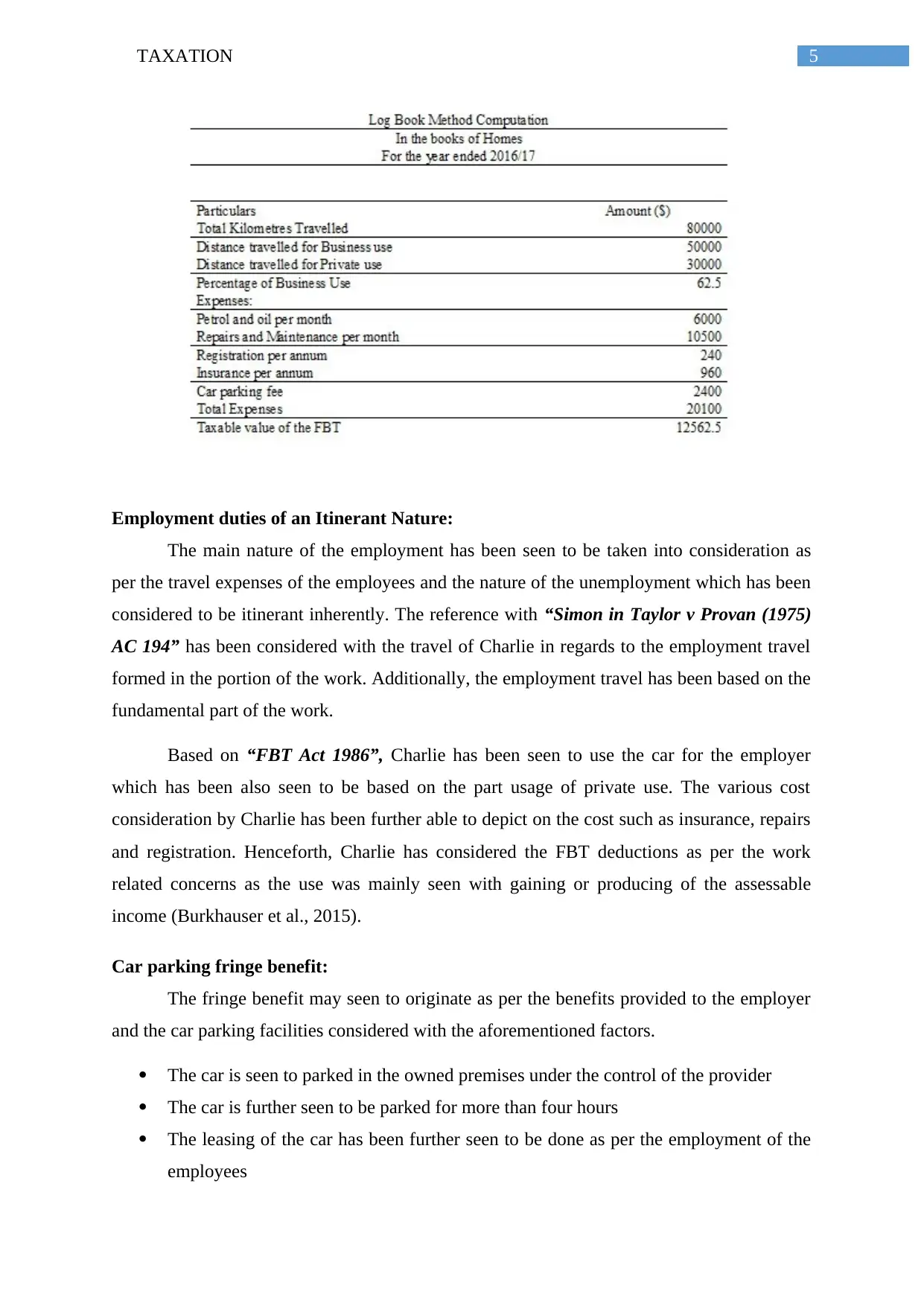
5TAXATION
Employment duties of an Itinerant Nature:
The main nature of the employment has been seen to be taken into consideration as
per the travel expenses of the employees and the nature of the unemployment which has been
considered to be itinerant inherently. The reference with “Simon in Taylor v Provan (1975)
AC 194” has been considered with the travel of Charlie in regards to the employment travel
formed in the portion of the work. Additionally, the employment travel has been based on the
fundamental part of the work.
Based on “FBT Act 1986”, Charlie has been seen to use the car for the employer
which has been also seen to be based on the part usage of private use. The various cost
consideration by Charlie has been further able to depict on the cost such as insurance, repairs
and registration. Henceforth, Charlie has considered the FBT deductions as per the work
related concerns as the use was mainly seen with gaining or producing of the assessable
income (Burkhauser et al., 2015).
Car parking fringe benefit:
The fringe benefit may seen to originate as per the benefits provided to the employer
and the car parking facilities considered with the aforementioned factors.
The car is seen to parked in the owned premises under the control of the provider
The car is further seen to be parked for more than four hours
The leasing of the car has been further seen to be done as per the employment of the
employees
Employment duties of an Itinerant Nature:
The main nature of the employment has been seen to be taken into consideration as
per the travel expenses of the employees and the nature of the unemployment which has been
considered to be itinerant inherently. The reference with “Simon in Taylor v Provan (1975)
AC 194” has been considered with the travel of Charlie in regards to the employment travel
formed in the portion of the work. Additionally, the employment travel has been based on the
fundamental part of the work.
Based on “FBT Act 1986”, Charlie has been seen to use the car for the employer
which has been also seen to be based on the part usage of private use. The various cost
consideration by Charlie has been further able to depict on the cost such as insurance, repairs
and registration. Henceforth, Charlie has considered the FBT deductions as per the work
related concerns as the use was mainly seen with gaining or producing of the assessable
income (Burkhauser et al., 2015).
Car parking fringe benefit:
The fringe benefit may seen to originate as per the benefits provided to the employer
and the car parking facilities considered with the aforementioned factors.
The car is seen to parked in the owned premises under the control of the provider
The car is further seen to be parked for more than four hours
The leasing of the car has been further seen to be done as per the employment of the
employees
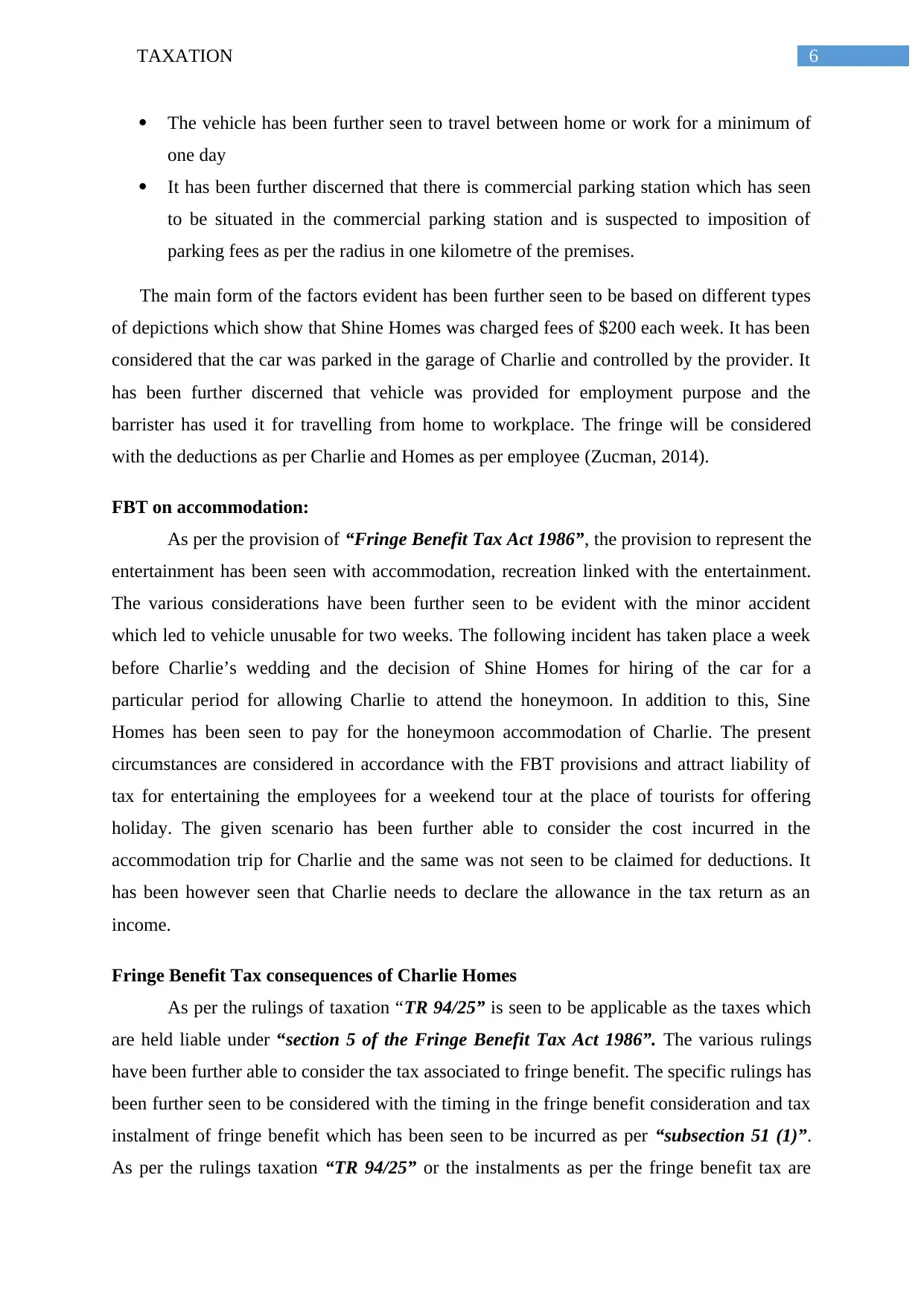
6TAXATION
The vehicle has been further seen to travel between home or work for a minimum of
one day
It has been further discerned that there is commercial parking station which has seen
to be situated in the commercial parking station and is suspected to imposition of
parking fees as per the radius in one kilometre of the premises.
The main form of the factors evident has been further seen to be based on different types
of depictions which show that Shine Homes was charged fees of $200 each week. It has been
considered that the car was parked in the garage of Charlie and controlled by the provider. It
has been further discerned that vehicle was provided for employment purpose and the
barrister has used it for travelling from home to workplace. The fringe will be considered
with the deductions as per Charlie and Homes as per employee (Zucman, 2014).
FBT on accommodation:
As per the provision of “Fringe Benefit Tax Act 1986”, the provision to represent the
entertainment has been seen with accommodation, recreation linked with the entertainment.
The various considerations have been further seen to be evident with the minor accident
which led to vehicle unusable for two weeks. The following incident has taken place a week
before Charlie’s wedding and the decision of Shine Homes for hiring of the car for a
particular period for allowing Charlie to attend the honeymoon. In addition to this, Sine
Homes has been seen to pay for the honeymoon accommodation of Charlie. The present
circumstances are considered in accordance with the FBT provisions and attract liability of
tax for entertaining the employees for a weekend tour at the place of tourists for offering
holiday. The given scenario has been further able to consider the cost incurred in the
accommodation trip for Charlie and the same was not seen to be claimed for deductions. It
has been however seen that Charlie needs to declare the allowance in the tax return as an
income.
Fringe Benefit Tax consequences of Charlie Homes
As per the rulings of taxation “TR 94/25” is seen to be applicable as the taxes which
are held liable under “section 5 of the Fringe Benefit Tax Act 1986”. The various rulings
have been further able to consider the tax associated to fringe benefit. The specific rulings has
been further seen to be considered with the timing in the fringe benefit consideration and tax
instalment of fringe benefit which has been seen to be incurred as per “subsection 51 (1)”.
As per the rulings taxation “TR 94/25” or the instalments as per the fringe benefit tax are
The vehicle has been further seen to travel between home or work for a minimum of
one day
It has been further discerned that there is commercial parking station which has seen
to be situated in the commercial parking station and is suspected to imposition of
parking fees as per the radius in one kilometre of the premises.
The main form of the factors evident has been further seen to be based on different types
of depictions which show that Shine Homes was charged fees of $200 each week. It has been
considered that the car was parked in the garage of Charlie and controlled by the provider. It
has been further discerned that vehicle was provided for employment purpose and the
barrister has used it for travelling from home to workplace. The fringe will be considered
with the deductions as per Charlie and Homes as per employee (Zucman, 2014).
FBT on accommodation:
As per the provision of “Fringe Benefit Tax Act 1986”, the provision to represent the
entertainment has been seen with accommodation, recreation linked with the entertainment.
The various considerations have been further seen to be evident with the minor accident
which led to vehicle unusable for two weeks. The following incident has taken place a week
before Charlie’s wedding and the decision of Shine Homes for hiring of the car for a
particular period for allowing Charlie to attend the honeymoon. In addition to this, Sine
Homes has been seen to pay for the honeymoon accommodation of Charlie. The present
circumstances are considered in accordance with the FBT provisions and attract liability of
tax for entertaining the employees for a weekend tour at the place of tourists for offering
holiday. The given scenario has been further able to consider the cost incurred in the
accommodation trip for Charlie and the same was not seen to be claimed for deductions. It
has been however seen that Charlie needs to declare the allowance in the tax return as an
income.
Fringe Benefit Tax consequences of Charlie Homes
As per the rulings of taxation “TR 94/25” is seen to be applicable as the taxes which
are held liable under “section 5 of the Fringe Benefit Tax Act 1986”. The various rulings
have been further able to consider the tax associated to fringe benefit. The specific rulings has
been further seen to be considered with the timing in the fringe benefit consideration and tax
instalment of fringe benefit which has been seen to be incurred as per “subsection 51 (1)”.
As per the rulings taxation “TR 94/25” or the instalments as per the fringe benefit tax are
Paraphrase This Document
Need a fresh take? Get an instant paraphrase of this document with our AI Paraphraser
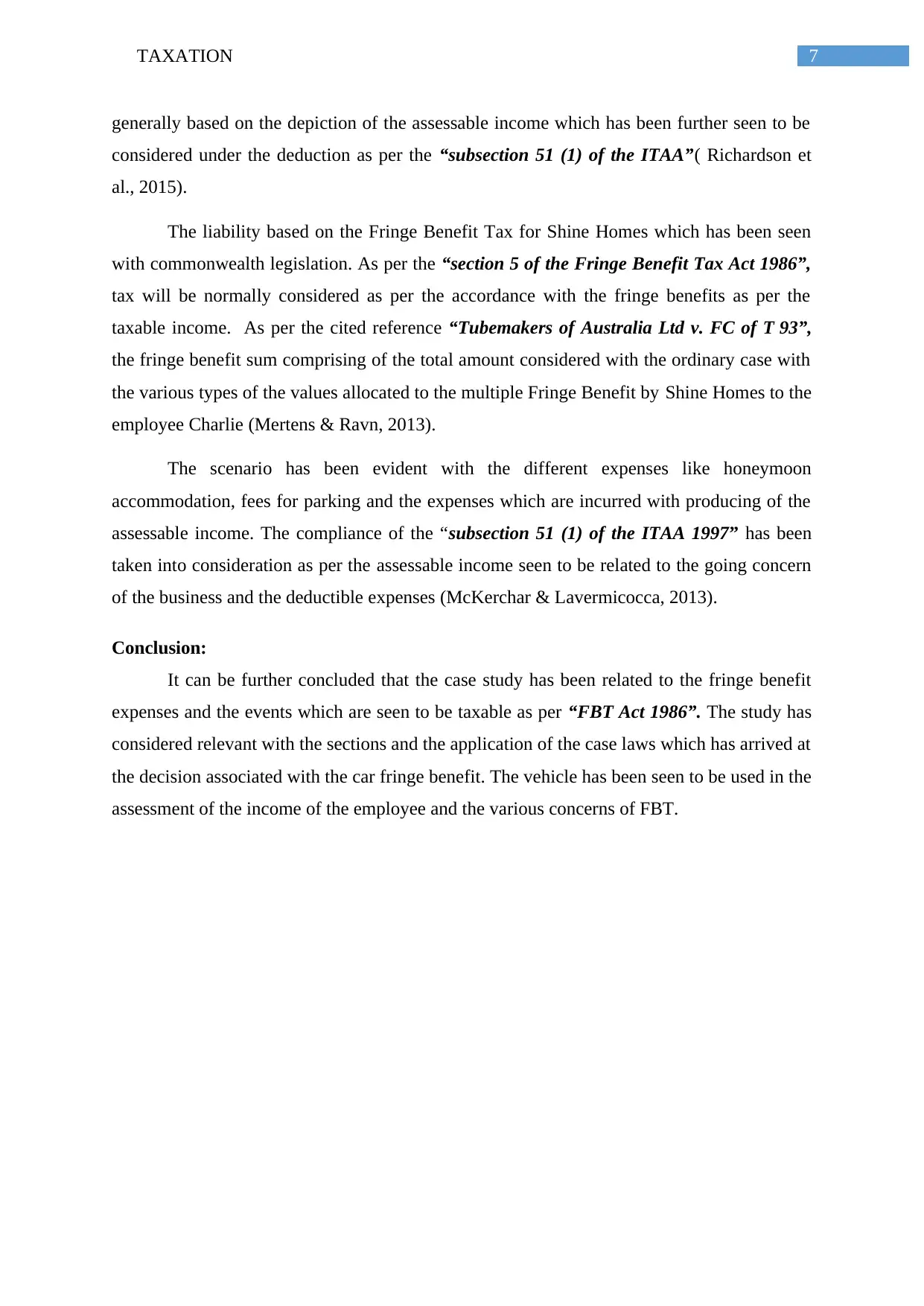
7TAXATION
generally based on the depiction of the assessable income which has been further seen to be
considered under the deduction as per the “subsection 51 (1) of the ITAA”( Richardson et
al., 2015).
The liability based on the Fringe Benefit Tax for Shine Homes which has been seen
with commonwealth legislation. As per the “section 5 of the Fringe Benefit Tax Act 1986”,
tax will be normally considered as per the accordance with the fringe benefits as per the
taxable income. As per the cited reference “Tubemakers of Australia Ltd v. FC of T 93”,
the fringe benefit sum comprising of the total amount considered with the ordinary case with
the various types of the values allocated to the multiple Fringe Benefit by Shine Homes to the
employee Charlie (Mertens & Ravn, 2013).
The scenario has been evident with the different expenses like honeymoon
accommodation, fees for parking and the expenses which are incurred with producing of the
assessable income. The compliance of the “subsection 51 (1) of the ITAA 1997” has been
taken into consideration as per the assessable income seen to be related to the going concern
of the business and the deductible expenses (McKerchar & Lavermicocca, 2013).
Conclusion:
It can be further concluded that the case study has been related to the fringe benefit
expenses and the events which are seen to be taxable as per “FBT Act 1986”. The study has
considered relevant with the sections and the application of the case laws which has arrived at
the decision associated with the car fringe benefit. The vehicle has been seen to be used in the
assessment of the income of the employee and the various concerns of FBT.
generally based on the depiction of the assessable income which has been further seen to be
considered under the deduction as per the “subsection 51 (1) of the ITAA”( Richardson et
al., 2015).
The liability based on the Fringe Benefit Tax for Shine Homes which has been seen
with commonwealth legislation. As per the “section 5 of the Fringe Benefit Tax Act 1986”,
tax will be normally considered as per the accordance with the fringe benefits as per the
taxable income. As per the cited reference “Tubemakers of Australia Ltd v. FC of T 93”,
the fringe benefit sum comprising of the total amount considered with the ordinary case with
the various types of the values allocated to the multiple Fringe Benefit by Shine Homes to the
employee Charlie (Mertens & Ravn, 2013).
The scenario has been evident with the different expenses like honeymoon
accommodation, fees for parking and the expenses which are incurred with producing of the
assessable income. The compliance of the “subsection 51 (1) of the ITAA 1997” has been
taken into consideration as per the assessable income seen to be related to the going concern
of the business and the deductible expenses (McKerchar & Lavermicocca, 2013).
Conclusion:
It can be further concluded that the case study has been related to the fringe benefit
expenses and the events which are seen to be taxable as per “FBT Act 1986”. The study has
considered relevant with the sections and the application of the case laws which has arrived at
the decision associated with the car fringe benefit. The vehicle has been seen to be used in the
assessment of the income of the employee and the various concerns of FBT.

8TAXATION
References
Adebisi, J. F., & Gbegi, D. O. (2013). Effect of Tax Avoidance and Tax Evasion on Personal
Income Tax Administration in Nigeria. American Journal of Humanities and Social
Sciences, 1(3). https://doi.org/10.11634/232907811301328
Blaufus, K., Eichfelder, S., & Hundsdoerfer, J. (2014). Income Tax Compliance Costs of
Working Individuals: Empirical Evidence from Germany. Public Finance Review, 42,
800–829. https://doi.org/10.1177/1091142113488162
Burkhauser, R. V., Hahn, M. H., & Wilkins, R. (2015). Measuring top incomes using tax
record data: a cautionary tale from Australia. The Journal of Economic Inequality, 13(2),
181–205. https://doi.org/10.1007/s10888-014-9281-z
Lin, L., & Flannery, M. J. (2013). Do personal taxes affect capital structure? Evidence from
the 2003 tax cut. Journal of Financial Economics, 109(2), 549–565.
https://doi.org/10.1016/j.jfineco.2013.03.010
McKerchar, M., & Lavermicocca, C. (2013). The impact of managing tax risk on the tax
compliance behaviour of large Australian companies. Australian Tax Forum, 28, 17.
Mertens, K., & Ravn, M. O. (2013). The dynamic effects of personal and corporate income
tax changes in the United States. American Economic Review.
https://doi.org/10.1257/aer.103.4.1212
Richardson, G., Taylor, G., & Lanis, R. (2015). The impact of financial distress on corporate
tax avoidance spanning the global financial crisis: Evidence from Australia. Economic
Modelling, 44, 44–53. https://doi.org/10.1016/j.econmod.2014.09.015
Richardson, G., Taylor, G., & Wright, C. S. (2014). Corporate profiling of tax-malfeasance:
A theoretical and empirical assessment of tax-audited Australian firms. eJournal of Tax
Research, 12(2), 359–382.
Taylor, G., & Richardson, G. (2014). Incentives for corporate tax planning and reporting:
Empirical evidence from Australia. Journal of Contemporary Accounting and
Economics, 10(1), 1–15. https://doi.org/10.1016/j.jcae.2013.11.003
Taylor, G., Richardson, G., & Taplin, R. (2015). Determinants of tax haven utilization:
Evidence from Australian firms. Accounting and Finance, 55(2), 545–574.
References
Adebisi, J. F., & Gbegi, D. O. (2013). Effect of Tax Avoidance and Tax Evasion on Personal
Income Tax Administration in Nigeria. American Journal of Humanities and Social
Sciences, 1(3). https://doi.org/10.11634/232907811301328
Blaufus, K., Eichfelder, S., & Hundsdoerfer, J. (2014). Income Tax Compliance Costs of
Working Individuals: Empirical Evidence from Germany. Public Finance Review, 42,
800–829. https://doi.org/10.1177/1091142113488162
Burkhauser, R. V., Hahn, M. H., & Wilkins, R. (2015). Measuring top incomes using tax
record data: a cautionary tale from Australia. The Journal of Economic Inequality, 13(2),
181–205. https://doi.org/10.1007/s10888-014-9281-z
Lin, L., & Flannery, M. J. (2013). Do personal taxes affect capital structure? Evidence from
the 2003 tax cut. Journal of Financial Economics, 109(2), 549–565.
https://doi.org/10.1016/j.jfineco.2013.03.010
McKerchar, M., & Lavermicocca, C. (2013). The impact of managing tax risk on the tax
compliance behaviour of large Australian companies. Australian Tax Forum, 28, 17.
Mertens, K., & Ravn, M. O. (2013). The dynamic effects of personal and corporate income
tax changes in the United States. American Economic Review.
https://doi.org/10.1257/aer.103.4.1212
Richardson, G., Taylor, G., & Lanis, R. (2015). The impact of financial distress on corporate
tax avoidance spanning the global financial crisis: Evidence from Australia. Economic
Modelling, 44, 44–53. https://doi.org/10.1016/j.econmod.2014.09.015
Richardson, G., Taylor, G., & Wright, C. S. (2014). Corporate profiling of tax-malfeasance:
A theoretical and empirical assessment of tax-audited Australian firms. eJournal of Tax
Research, 12(2), 359–382.
Taylor, G., & Richardson, G. (2014). Incentives for corporate tax planning and reporting:
Empirical evidence from Australia. Journal of Contemporary Accounting and
Economics, 10(1), 1–15. https://doi.org/10.1016/j.jcae.2013.11.003
Taylor, G., Richardson, G., & Taplin, R. (2015). Determinants of tax haven utilization:
Evidence from Australian firms. Accounting and Finance, 55(2), 545–574.
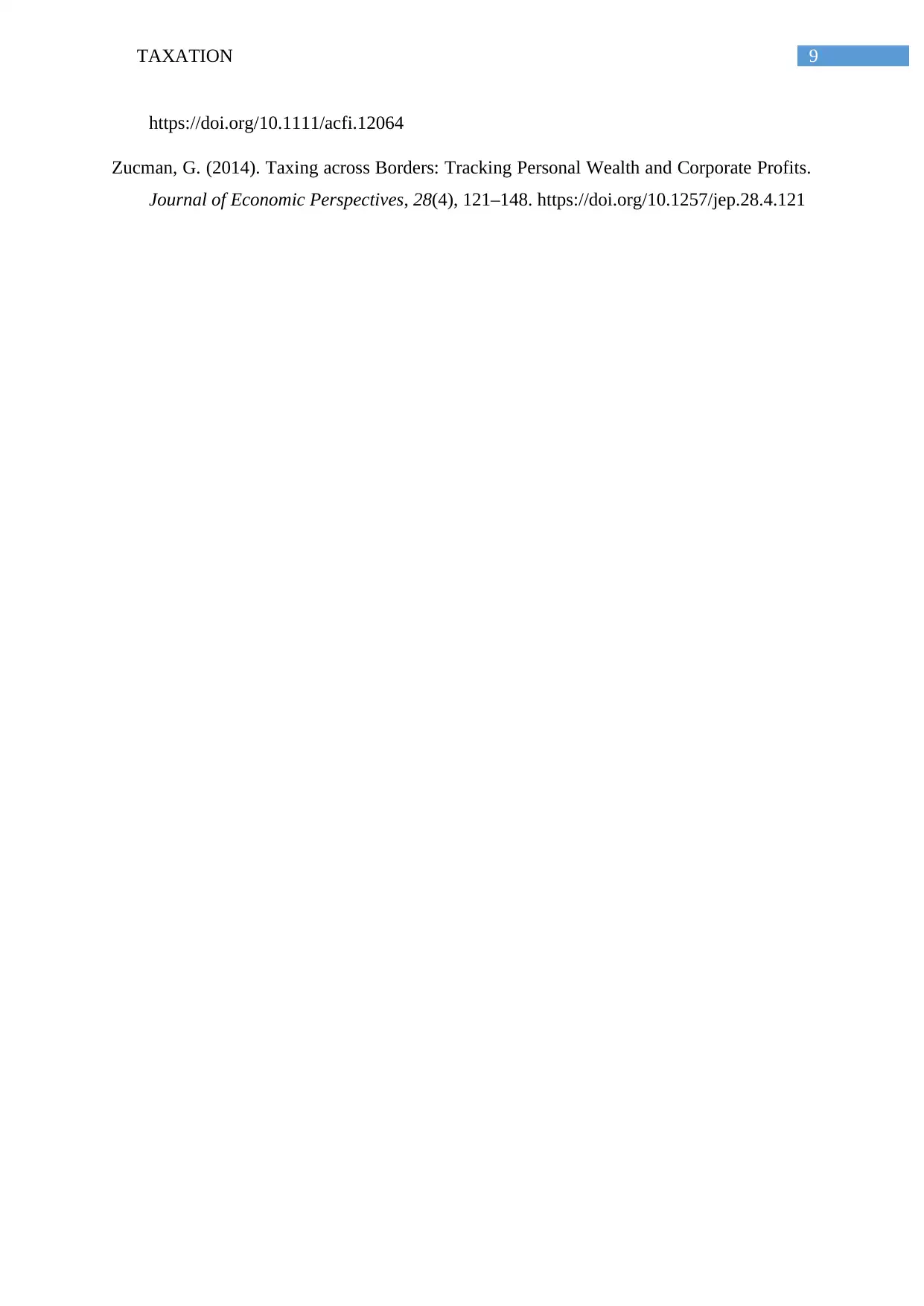
9TAXATION
https://doi.org/10.1111/acfi.12064
Zucman, G. (2014). Taxing across Borders: Tracking Personal Wealth and Corporate Profits.
Journal of Economic Perspectives, 28(4), 121–148. https://doi.org/10.1257/jep.28.4.121
https://doi.org/10.1111/acfi.12064
Zucman, G. (2014). Taxing across Borders: Tracking Personal Wealth and Corporate Profits.
Journal of Economic Perspectives, 28(4), 121–148. https://doi.org/10.1257/jep.28.4.121
1 out of 10
Related Documents
Your All-in-One AI-Powered Toolkit for Academic Success.
+13062052269
info@desklib.com
Available 24*7 on WhatsApp / Email
![[object Object]](/_next/static/media/star-bottom.7253800d.svg)
Unlock your academic potential
© 2024 | Zucol Services PVT LTD | All rights reserved.





